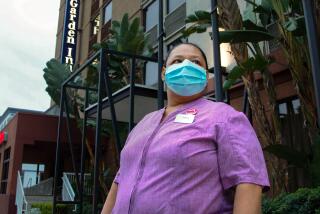It’s a Dirty Job
- Share via
Every other Wednesday at noon, housecleaning partners Dianne Kraus and Peggy Jackson pull up to a beige two-story house in Ithaca, N.Y. Although the owners are at work, the two women unlock the door and begin their orchestrated routine. For nearly three hours they vacuum, dust, polish and scrub, upstairs and down.
“It smells so good and looks so clean when we come home,” says Linda Klena, a nurse at Cornell University. She and her husband, a dean at Ithaca College, used to share the cleaning. “[But] there just was no way we could live our lives and clean the house simultaneously,” she says.
Samia Langlade of Needham, Mass., takes a different approach. After putting in long days as a travel agent during the week, she spends up to eight hours every other weekend cleaning her three-bedroom house. While favorite operas play on the CD, she moves furniture to vacuum, washes floors, cleans kitchen appliances and cares for her plants.
“When I finish, I feel like a bird --free,” Langlade says. “It has never crossed my mind to hire someone to clean my house. It’s not that I don’t trust people. It’s just that the way they work doesn’t satisfy me.”
Call this a tale of two cleaning styles and consider it a 1990s microcosm of Americans’ ongoing attempt to conquer the three Ds of domesticity: dust, dirt and disorder. With more families earning two incomes and working longer hours, questions such as “Who will clean, and when?” and “How clean is clean?” loom large. “We don’t have cleaning days anymore--we have hours, we have minutes,” says Don Aslett, who has written on housework.
To maximize that time, more households are turning to cleaning companies or independent cleaners. One of the largest chains, Merry Maids, which operates 800 franchises in the United States, grew between 15% and 20% for each of the past five years, says spokeswoman Sarah Smock. Yet the cleaning industry as a whole, Aslett observes, remains “a struggling business,” with a failure rate of nearly 97%.
Among those hiring outside help, two-career couples with children make up the largest group. Senior citizens rank second. Seventy percent of Merry Maids customers use weekly or biweekly services.
For some families, hiring outside help is a priority even when budgets are modest. “Some people can’t afford to hire me, but they can’t live without me,” says Laura Sullivan of Norfolk, Mass.
*
As a professional cleaner, Kraus observes wide variations in customers’ cleaning patterns. “Some are kind of obsessive, some are real lax, and most are somewhere in the middle.”
Equally varied are people’s views on the choice between cleaning services and independent cleaners. Some clients say services provide greater reliability: If one employee can’t make it, the company sends someone else.
Those who like services also point out the advantage of not having to pay taxes, Social Security and insurance for household employees--details the company handles. Yet revised tax laws have simplified reporting and payment provisions. Clients who pay an independent household employee cash wages of $1,000 or more annually now pay employment taxes only once a year by attaching a new form, Schedule H, to their 1040 form.
Private cleaners generally charge less than cleaning companies. Homeowners interviewed pay individuals wages ranging from $45 to $70 for an average of three hours work. Nationally, Smock says, costs for a service such as Merry Maids average between $65 and $70 for weekly cleaning.
But all figures come with a caveat. Jeff Campbell, founder of the Clean Team cleaning service in San Francisco, says, “If you had two identical houses next door, one might have a husband and wife, three kids, a dog, a cat and a parrot. The other might have two working professionals with no kids who never cook and never use the second bathroom.”
Cleaning still falls most heavily on women. “Men are still pretty lax about doing their fair share,” Campbell says.
Still, experts see signs of change. In 1980, Aslett recalls, audiences for his housecleaning seminars often included only one man among 300 women. Today men make up one-third of some audiences.
For men and women, Campbell says, the “biggest pitfall” in cleaning is a lack of know-how. “They take out the Windex and walk around looking for things to put it on. Then they do the same with furniture polish.”
More to Read
Inside the business of entertainment
The Wide Shot brings you news, analysis and insights on everything from streaming wars to production — and what it all means for the future.
You may occasionally receive promotional content from the Los Angeles Times.










